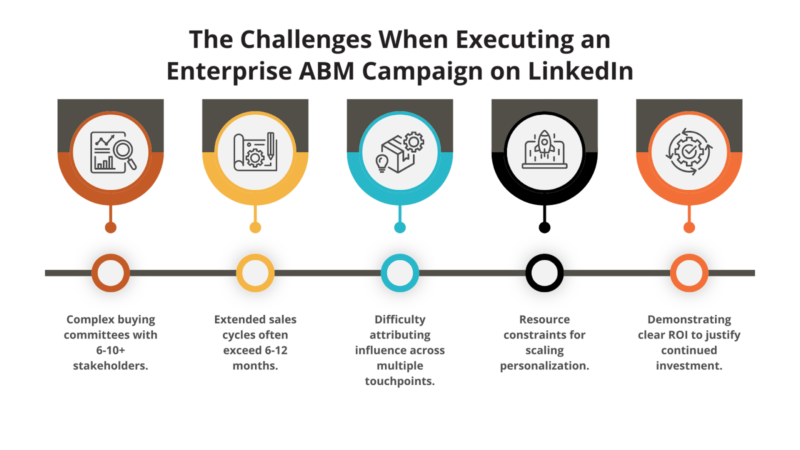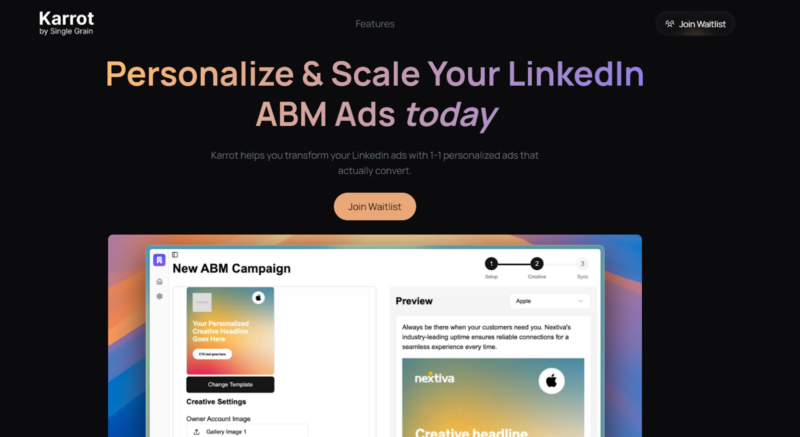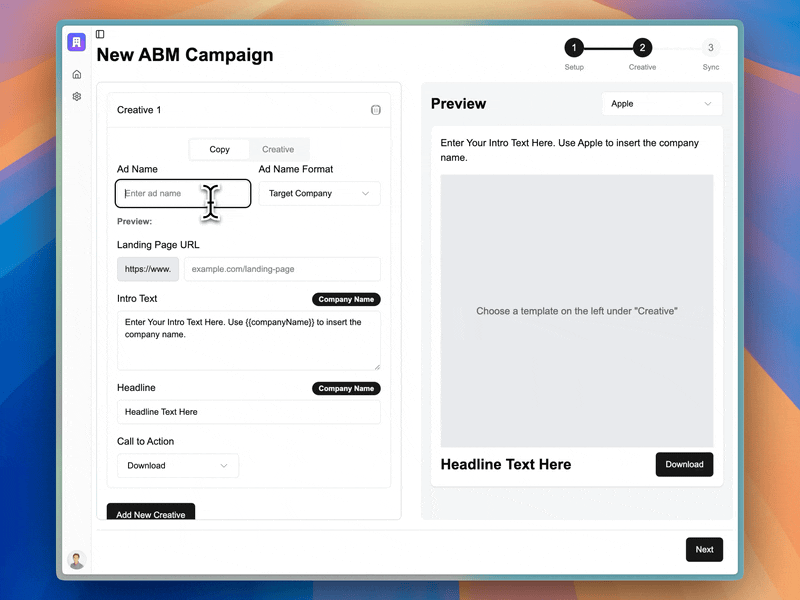Enterprises face unique challenges when implementing account-based marketing (ABM) strategies on LinkedIn. While LinkedIn offers the potential to convert high-value accounts, demonstrating clear return on investment (ROI) often proves challenging due to complex buying cycles and multiple stakeholders.
This is where Karrot.ai comes in. This is a strategic ABM tool used to create targeted ads on LinkedIn. Karrot.ai offers many benefits, such as advanced targeting and AI-powered personalization. Here’s why Karrot.ai improves ROI and can help your brand become a revenue-generating machine on LinkedIn.
Key Highlights
- Enterprise LinkedIn ABM campaigns drive 25% higher measurable ROI when using AI-powered personalization tools.
- 97% of marketers report that ABM delivers a higher return on investment than other marketing strategies.
- Multi-touch attribution models are essential for accurately measuring enterprise ABM campaign performance.
- Personalization at scale is the key differentiator for high-performing enterprise LinkedIn campaigns.
- AI-powered tools like Karrot.ai enable enterprise-level personalization without proportional resource requirements.
- Closed-loop reporting between marketing and sales systems provides the most accurate ROI measurement.
- Enterprise ABM campaigns typically influence 73% of total revenue from target accounts.
- Continuous optimization based on performance data can improve campaign ROI by 30% over time.
TABLE OF CONTENTS:
Executing an Enterprise ABM Campaign on LinkedIn
To execute a successful ABM campaign, marketers must target high-value accounts with personalized marketing. This requires more than an aligned sales and marketing team–ABM professionals must have the right technology and systems to foster account loyalty and maximize ROI.
When ABM is executed correctly, the results pay off. According to a study, 19% of companies that used ABM for at least a year reported over 30% revenue growth.

But how can enterprise companies get those results? While LinkedIn is the first place that enterprise organizations may turn to, they may also face unique challenges:
- Complex buying committees with 6-10+ stakeholders.
- Extended sales cycles often exceed 6-12 months.
- Difficulty attributing influence across multiple touchpoints.
- Resource constraints for scaling personalization.
- Demonstrating clear ROI to justify continued investment.
Enterprises can still use LinkedIn to target high-value accounts. The key is to deliver relevant experiences to each stakeholder while maintaining efficiency at scale.
Maximizing ROI for Enterprise ABM
97% of B2B marketers say they get a high ROI with ABM. However, maximizing ABM ROI requires a firm understanding of target accounts, creating personalized content, and measuring performance. All these tasks are difficult to achieve without automation.
Defining Enterprise ABM ROI
Enterprise ABM ROI requires a more sophisticated approach than traditional marketing metrics. Marketers can start calculating ROI by using this formula:
ABM ROI = (Revenue Influenced by ABM – ABM Program Cost) / ABM Program Cost
However, this still masks several complexities:
- Revenue influence: Determining what portion of revenue was influenced by ABM activities.
- Program costs: Fully accounting for technology, creative, media, and personnel costs.
- Time horizon: Accounting for extended sales cycles in enterprise deals.
- Attribution modeling: Properly crediting influence across multiple touchpoints.
This is why setting a budget is integral to making a return on ABM.
Step 1: Establish Your ROI Measurement Framework
Before launching your enterprise LinkedIn ABM campaign, establish a clear framework for measuring ROI. Here are essential metrics to measure:
Multi-Level Metrics Framework
| Metric Level | Example Metrics | Purpose |
|---|---|---|
| Activity Metrics | Impressions, clicks, engagement | Measure campaign execution |
| Response Metrics | Account engagement, content downloads | Measure target account response |
| Impact Metrics | Pipeline influence, revenue contribution | Measure business outcomes |
| Efficiency Metrics | Cost per acquisition, ROI | Measure program efficiency |
This multi-level approach ensures you track leading indicators (activity and response) and lagging indicators (impact and efficiency) to get a complete picture of campaign performance.
Attribution Model Selection
Enterprise ABM requires different types of attribution models:
- First-touch attribution: Credits the first touchpoint that engaged the account.
- Last-touch attribution: Credits the final touchpoint before conversion.
- Multi-touch attribution: Distributes credit across all touchpoints.
- Position-based attribution: Weights credit based on touchpoint position.
- Time-decay attribution: Gives more credit to recent touchpoints.
Step 2: Implement Closed-Loop Reporting
Accurate ROI measurement requires seamless data flow between marketing and sales systems:
Closed-Loop Reporting
Closed-loop marketing is the process of analyzing data throughout the entirety of the customer journey. ABM marketers can use this technology to assist closed-loop reporting:
- LinkedIn Campaign Manager: Captures ad performance data.
- Marketing automation: Tracks engagement and nurture activities.
- CRM system: Records opportunity and revenue data.
- ABM platform: Provides account-level engagement insights.
- Business intelligence tool: Combines data for comprehensive analysis.
This integrated approach ensures that LinkedIn campaign data can directly connect to pipeline and revenue outcomes, providing a clear view of ROI.
Key Integration Points
Here are the key points that will maximize ROI:
- LinkedIn Lead Gen Forms connected to CRM
- LinkedIn Insight Tag for website activity tracking
- UTM parameters for source attribution
- CRM campaign influence tracking
- Opportunity stage progression monitoring
Step 3: Leverage AI for Personalization at Scale
The key to driving measurable ROI in enterprise LinkedIn ABM is delivering personalized experiences at scale. This is where AI-powered tools like Karrot.ai transform what’s possible.
AI-Powered Personalization Capabilities
AI tools use data analysis and predictive capabilities to identify interests and behaviors that will personalize content. Here’s a deeper look into how it works:
- Dynamic content generation that automatically personalizes ad creative for each account
- Role-based messaging tailored to different stakeholders within target accounts
- Industry-specific value propositions that resonate with each account’s context
- Engagement-based optimization that refines messaging based on response
- Scalable personalization that maintains quality across hundreds or thousands of accounts
Companies implementing 1-1 personalized LinkedIn ads with tools like Karrot.ai report conversion rate improvements of up to 70% compared to generic campaigns, directly impacting ROI through improved pipeline conversion.
The Karrot.ai Advantage for Enterprise ABM

Karrot.ai specifically addresses enterprise personalization challenges through:
- Enterprise-grade scalability that supports thousands of target accounts
- Role-based personalization for reaching different buying committee members
- Integration with enterprise martech stacks for seamless data flow
- Compliance and brand governance features that abide by privacy regulations
- Advanced analytics that connect personalization to performance outcomes
Karrot.ai enables enterprise marketers to deliver truly personalized experiences without complexity or wasted resources.
Step 4: Implement Multi-Stakeholder Targeting
Enterprise buying decisions involve multiple stakeholders with different priorities and concerns. Effective LinkedIn ABM campaigns address this complexity through multi-stakeholder targeting. Here’s how Karrot.ai makes this process easier.
Stakeholder Mapping
Identifying and mapping key stakeholders is the first step in ABM. But Karrot.ai takes this a step further using these methods:
- Economic buyers: Focus on business outcomes and ROI.
- Technical evaluators: Concerned with capabilities and implementation.
- End users: Interested in usability and day-to-day benefits.
- Procurement: Focused on terms, pricing, and vendor management.
- Executive sponsors: Looking for strategic alignment and value.
Organizations with a well-defined ICP achieve 68% higher account win rates by ensuring all decision-makers receive relevant messaging.
Role-Based Campaign Structure
Structure your LinkedIn campaigns to address these different stakeholders:
| Stakeholder Role | Content Focus | Call-to-Action | Success Metrics |
|---|---|---|---|
| C-Suite | Strategic value, ROI | Executive briefing | Executive engagement |
| Directors | Operational impact | Solution overview | Assessment requests |
| Managers | Implementation details | Technical demo | Demo attendance |
| End Users | Usability, features | Product tour | Feature engagement |
This structured approach ensures each stakeholder receives messaging relevant to their role and concerns, increasing overall campaign effectiveness.
Step 5: Implement Advanced Measurement Techniques
Beyond basic attribution, several advanced techniques can improve the way marketers measure ROI. Here are a few recommended methods.
Account Engagement Scoring
Develop a comprehensive engagement scoring model that weights different interactions, such as:
- Basic engagement: Ad clicks, website visits (1 point).
- Content engagement: Downloads, video views (3 points).
- High-intent actions: Demo requests, pricing pages (5 points).
- Direct response: Form submissions, meeting requests (10 points).
This scoring approach provides a more nuanced view of campaign impact.
Influenced Pipeline Analysis
While ABM campaigns have a 1.74x better pipeline ROI, it’s still integral to track how LinkedIn ABM campaigns influence sales funnel development. Here are areas to track:
- New opportunity influence: Campaigns that help create new opportunities.
- Acceleration influence: Campaigns that speed up existing opportunities.
- Expansion influence: Campaigns that increase deal size.
- Competitive displacement: Campaigns that help win competitive situations.
This multi-dimensional analysis provides a more complete picture of campaign impact on revenue outcomes.
Lift Analysis
Lift analysis is one of the most challenging aspects of ABM. Measure the performance lift between targeted and non-targeted accounts using these methods:
- Engagement lift: Increase in engagement rates for targeted accounts.
- Conversion lift: Improvement in conversion rates for targeted accounts.
- Velocity lift: Reduction in sales cycle length for targeted accounts.
- Value lift: Increase in average deal size for targeted accounts.
Step 6: Optimize for Continuous ROI Improvement
Enterprise LinkedIn ABM is not a “set it and forget it” strategy. Marketers must continually review their programs, revise their account targeting tactics, and improve their messaging. That’s because continuous ABM optimization is essential for maximizing ROI.
Optimization Framework
Implement a structured optimization process, such as by using this schedule:
- Weekly: Review activity metrics and make tactical adjustments.
- Monthly: Analyze response metrics and refine targeting/creative.
- Quarterly: Evaluate impact metrics and adjust strategic approach.
- Annually: Conduct comprehensive ROI analysis and program planning.
This multi-tiered approach ensures both short-term performance improvements and long-term strategic alignment.
Key Optimization Levers
Focus optimization efforts on these high-impact areas:
- Audience refinement: Continuously improve target account selection.
- Creative optimization: Test and refine messaging and visual elements.
- Budget allocation: Shift resources towardthe highest-performing segments.
- Channel integration: Coordinate LinkedIn efforts with other channels.
- Sales alignment: Improve handoff processes and follow-up protocols.
Case Study: Enterprise Tech Company Transforms ABM ROI with Karrot.ai
A global enterprise software company implemented an advanced LinkedIn ABM strategy targeting 1,000 enterprise accounts across multiple industries. Using Karrot.ai to power personalization at scale, they:
- Created industry-specific messaging for eight key verticals.
- Developed role-based creative for five stakeholder groups.
- Implemented account-specific personalization for their top 100 accounts.
- Established closed-loop reporting between LinkedIn, marketing automation, and CRM.
The results demonstrated the power of this approach:
- 187% increase in target account engagement
- 64% improvement in MQL-to-opportunity conversion
- 42% reduction in cost-per-acquisition
- 3.2X return on ad spend
- $12.4M in influenced pipeline within 6 months
The campaign’s success stemmed from the ability to deliver truly personalized experiences at enterprise scale without overwhelming their marketing team’s resources.
Best Practices for Enterprise LinkedIn ABM ROI
To maximize the ROI of your enterprise LinkedIn ABM campaigns, follow these proven best practices:
- Start with clear business objectives that connect directly to revenue outcomes
- Implement comprehensive tracking before launching campaigns
- Focus on quality over quantity in target account selection
- Qualify accounts before retargeting them
- Invest in ad personalization technology like Karrot.ai to enable scale
- Establish regular optimization cadences with clear accountability
- Celebrate and communicate wins to build organizational support
- Document ROI methodology to ensure consistent measurement over time
Maximize Your Enterprise LinkedIn ABM ROI Today
The ability to deliver personalized experiences at enterprise scale is what ultimately drives the exceptional ROI that makes ABM the strategy of choice for leading B2B marketers. While LinkedIn offers many tools for account-based targeting, ABM marketers will need additional help when maximizing ROI.
To achieve the highest enterprise LinkedIn ABM ROI, implement robust measurement frameworks, leverage AI-powered personalization, and continuously optimize performance. Lastly, the key is combining strategic targeting, personalized experiences, and comprehensive measurement to create a virtuous continuous improvement cycle.
For a more sophisticated strategy, invest in automation tools like Karrot.ai that can help you scale personalization without sacrificing quality or increasing workload.




